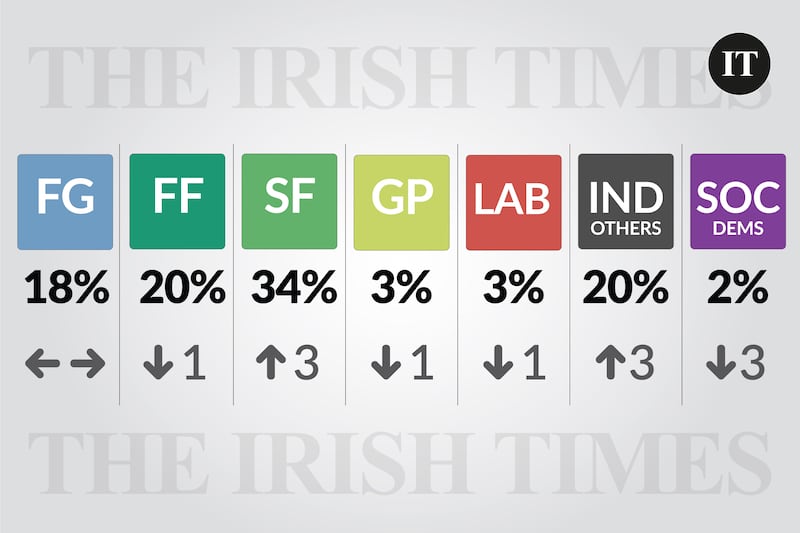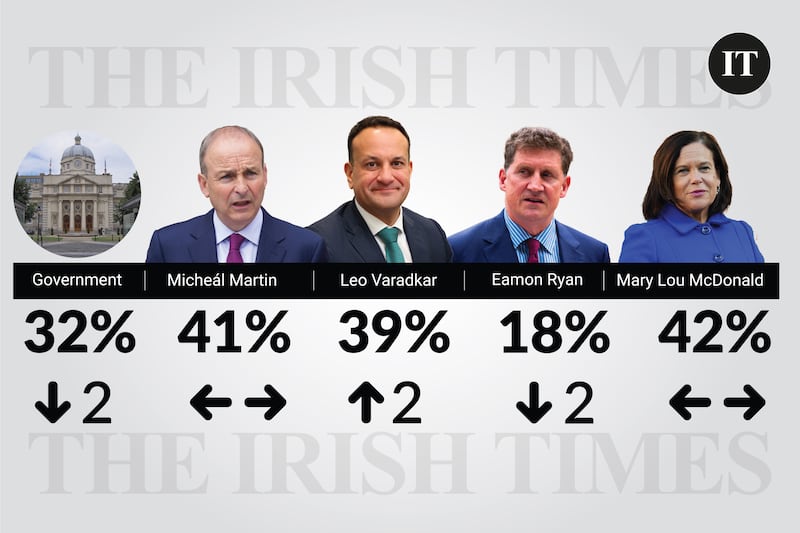As you were, so. The first Irish Times/Ipsos poll of the autumn political season shows political support returning to its pre-summer trend.
That, in summary, is a comfortable lead for Sinn Féin in the low to mid-30s; Fianna Fáil and Fine Gael both hovering around the 20 per cent mark; the smaller parties being squeezed; and Independents maintaining their strong, highly localised brands.
A slippage in support for Sinn Féin, evident in the first half of this year, has been reversed, with support increasing by three points to 34 per cent. With Mary Lou McDonald back from illness, the housing crisis continuing to hurt younger voters and a general election no more than 18 months away – and possibly sooner – the results will add to the party’s growing confidence that it will be, by some distance, the largest party in the next Dáil.
Sinn Féin chiefs have a job on their hands to find candidates to take all those votes, but with so many people, especially younger people, now saying they will vote for the party, the suspicion has to be that candidates will not matter as much to them. They are voting for McDonald, for Eoin Ó Broin, or for a cheaper house or lower rents rather than for the local face on the poster.
RM Block
Being the largest party in the Dáil, however, is not a guarantee of leading the next government. Assuming that Sinn Féin will not win an overall majority – and that is probably in the realms of fantasy – then McDonald will need to put together a working Dáil majority of at least 88 TDs if she is to lead a government.
With the small parties being squeezed on both sides by Sinn Féin and Independents, a Sinn Féin-led government of the left, which excludes Fine Gael and Fianna Fáil, seems even less likely after this poll than it did before.
With the Fine Gael leadership ruling it out and the wider party unlikely to permit a U-turn – especially, as seems currently likely, the election sees a further loss of seats for the party – that leaves Fianna Fáil.
What is not yet clear on this question is whether Fianna Fáil will have an alternative route to government. If today’s numbers were repeated on election day, that would seem unlikely. Certainly, a repeat of the current coalition seems unlikely. At the 2020 election, the combined support of Fianna Fáil, Fine Gael and the Greens was 50 per cent; now it’s 41 per cent.
[ Sinn Féin extends lead to stay on course to be largest party in next Dáil, latest opinion poll shows ]

Could Labour be tempted to join? Or the Social Democrats? Or, more likely perhaps, a handful of Independent TDs? On the basis of today’s numbers, it would have to be a very big handful indeed. And if that route doesn’t work for Fianna Fáil, it could be faced with the question of whether it wants to enter coalition negotiations with Sinn Féin – or face another general election. It increasingly looks like there are uncomfortable choices ahead for Micheál Martin and his party.

For Fine Gael, today’s numbers are even more worrying. Rooted on 18 per cent, the party has not been lower since 1994. Only among farmers is support for Fine Gael higher than Sinn Féin (and Fianna Fáil beats it there). On every single other demographic, Sinn Féin is ahead of Fine Gael – in Dublin, among better-off ABC1 voters, among the over-65s, etc, etc. Among the youngest cohort of voters, those aged 18-24, support for Sinn Féin (44 per cent) is four times that of Fine Gael (11 per cent).
Fine Gaelers will say that things change before elections – and they’re right. The result generally expected a year before every election since 2007 has not in fact manifested itself. But there’s no sign of things changing, no sign of what might change them, and – crucially – no sign that even if things do change, that Fine Gael will be the beneficiaries. In fact, given that the party will be seeking an unprecedented fourth term in office, a turnaround in Fine Gael’s favour seems a distant prospect indeed.
The enduring strength of Independents in Irish politics is again evident in today’s numbers. Independent candidates rise by four points to 18 per cent. As many people say they will vote Independent as Fine Gael. At least some of this is bleeding from the smaller parties, who are under pressure in today’s poll. The Greens and Labour both fall off by a point to 3 per cent, while People Before Profit-Solidarity are also down a point to just 1 per cent. Aontú is unchanged on 1 per cent.
There is big disappointment for the Social Democrats, who see the jump in support after Holly Cairns took over as leader earlier this year fall away completely. The Holly Hop has become the Holly Flop.
Politics is cruel sometimes. Cairns has demonstrated an ability to catch people’s attention, and that could be a priceless asset – but when she has that attention, she needs to make use of it. And like all the small parties, the Social Democrats are being squeezed, and squeezed hard, by the Sinn Féin juggernaut.












